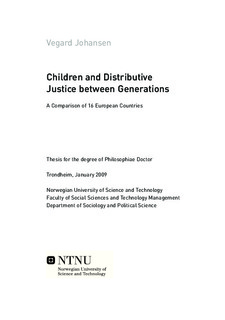| dc.contributor.advisor | Qvortrup, Jens | nb_NO |
| dc.contributor.advisor | Jensen, An-Magritt | nb_NO |
| dc.contributor.author | Johansen, Vegard | nb_NO |
| dc.date.accessioned | 2014-12-19T14:34:58Z | |
| dc.date.available | 2014-12-19T14:34:58Z | |
| dc.date.created | 2008-12-24 | nb_NO |
| dc.date.issued | 2009 | nb_NO |
| dc.identifier | 132665 | nb_NO |
| dc.identifier.isbn | 978-82-471-1388-2 | nb_NO |
| dc.identifier.uri | http://hdl.handle.net/11250/268082 | |
| dc.description.abstract | This thesis is a quantitative study of distributive justice between generations or age groups. It is theoretically informed by a synchronic generation approach and John Rawls’s theory of justice-as-fairness. The empirical part compares the economic positions of, and public spending on, children, adults and the elderly in 16 European countries.
The theoretical part is used as a platform for the empirical analysis. In addition to Rawls, a discussion of distributive justice includes the classical theories of Plato and Aristotle and more recent utilitarian, egalitarian and desert-based theories. The synchronic generation approach is presented and compared to diachronic approaches to studies of generational relations. The synchronic approach is theorized by scholars working in the tradition of the social studies of childhood.
The chapter on methods identifies children, adults and the old by way of age brackets, it presents indicators of public spending and income, and it points out empirical applications of equality, equal opportunity and the difference principle. The techniques of analyses are presented; descriptive analysis and OLS regression. The explanatory variables vary, but in all cases include economic performance, age structure and a modified version of Esping-Andersen`s classification of welfare states (Social Democratic, Conservative, Liberal and Southern European).
Six research questions are answered in the empirical part, using official statistics from Eurostat, OECD and Statistics Norway. Over the past few decades there is an extensive growth on spending on the elderly, but spending on family and children does not decline. Multivariate analyses indicate that the size of old age and family and child benefits vary across welfare regimes. The Social Democratic and Conservative welfare states are more egalitarian and have lower poverty rates compared to the Liberal and Southern European welfare states. These regime variances are also seen in multivariate analyses of child poverty and old age poverty. Risk factors for child poverty are parental unemployment, children living with single parents, young parents, ethnic parents, and low educated parents. A multivariate analysis points to a link between the size of family and child benefits and fertility rates.
| nb_NO |
| dc.language | eng | nb_NO |
| dc.publisher | Norges teknisk-naturvitenskapelige universitet, Fakultet for samfunnsvitenskap og teknologiledelse, Institutt for sosiologi og statsvitenskap | nb_NO |
| dc.relation.ispartofseries | Doctoral Theses at NTNU, 1503-8181; 2009:10 | nb_NO |
| dc.subject | Distributive justice | en_GB |
| dc.subject | John Rawls | en_GB |
| dc.subject | generation | en_GB |
| dc.subject | social studies of childhood | en_GB |
| dc.subject | public transfer | en_GB |
| dc.subject | disposable income | en_GB |
| dc.title | Children and Distributive Justice between Generations: A Comparison of 16 European Countries | nb_NO |
| dc.type | Doctoral thesis | nb_NO |
| dc.source.pagenumber | 272 | nb_NO |
| dc.contributor.department | Norges teknisk-naturvitenskapelige universitet, Fakultet for samfunnsvitenskap og teknologiledelse, Institutt for sosiologi og statsvitenskap | nb_NO |
| dc.description.degree | PhD i statsvitenskap | nb_NO |
| dc.description.degree | PhD in Political Science | en_GB |
